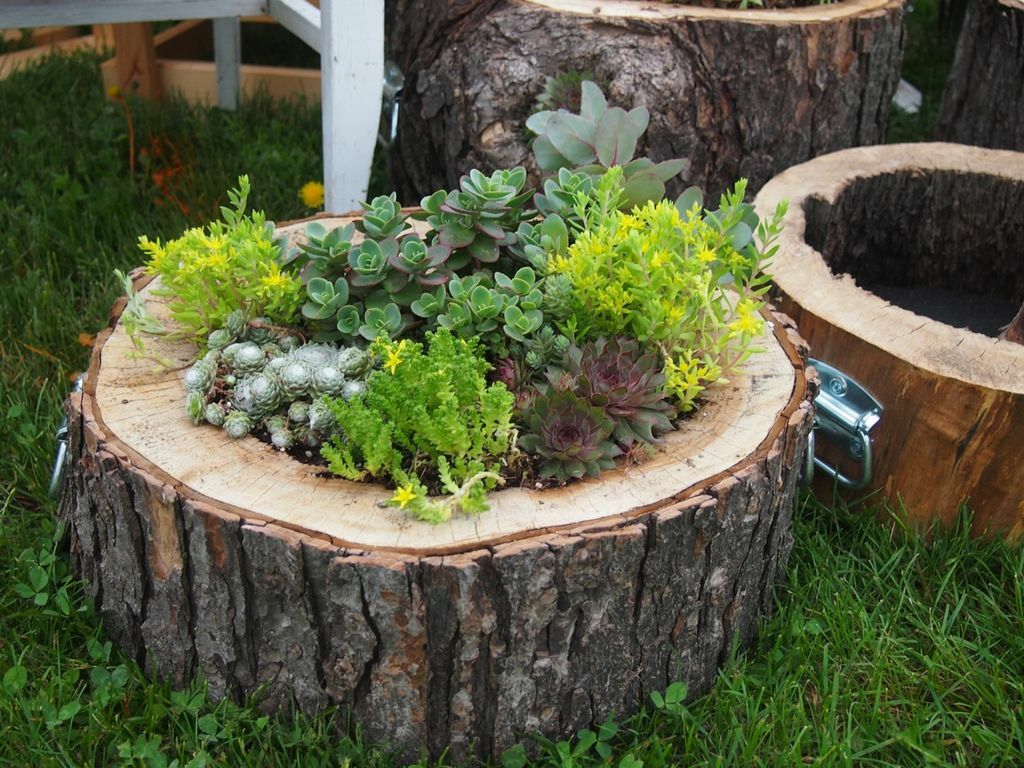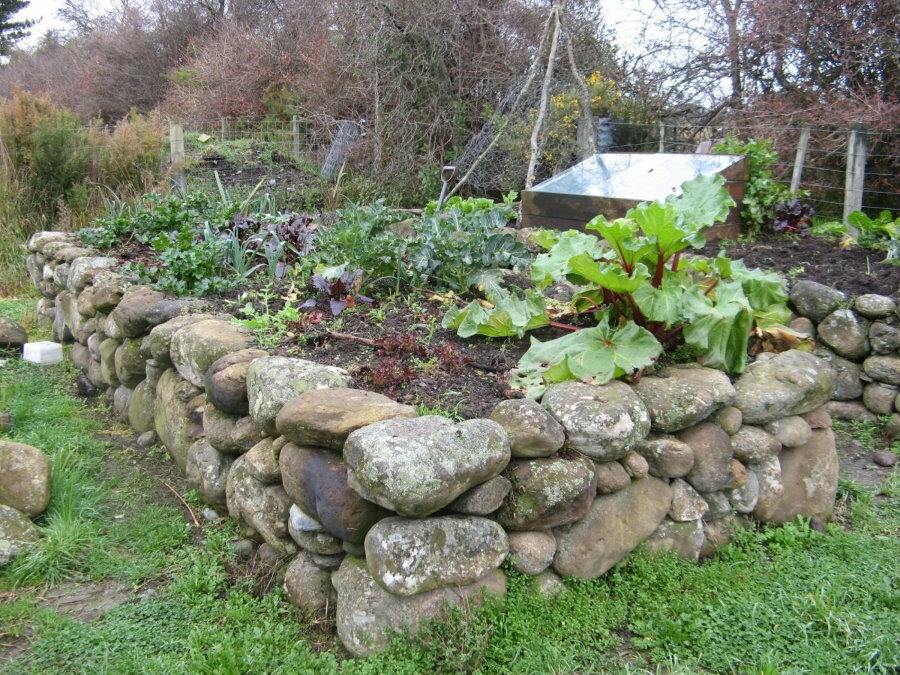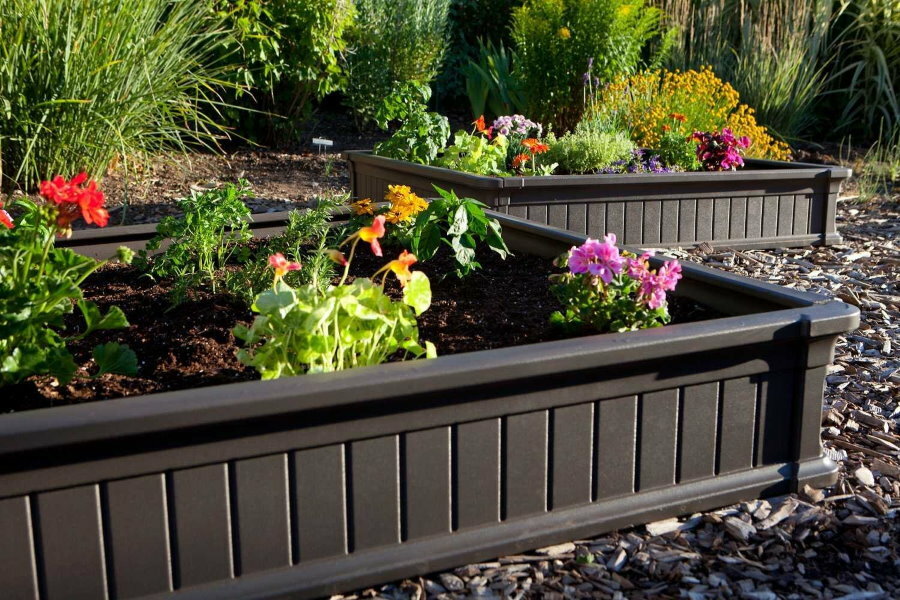It is difficult to overestimate the importance of fences and borders in the external decor of a country house or summer cottage. In addition to aesthetics and creating a certain atmosphere, fences are primarily erected for practical purposes. Curbs prevent slabs from sliding apart on paved walkways and keep dirt, leaves and grass from entering the walkways. During heavy rains, low fences prevent the accumulated moisture from draining onto the paths, thereby helping the drainage system to remove excess water outside the site.

A wide variety of materials can be used to fence the beds.
The functions of higher barriers are even more varied. Fences and enclosures protect planted and decorative areas from unauthorized entry of pets into them. They are also a protective barrier against dust streams, strong winds and small debris. And when darkness or fog sets in, the guardrails help to recognize subtle paths.
Car tires in decor
Content
- Car tires in decor
- Wood curb - everything is in your power
- Stone and concrete as fencing
- Concrete fence
- Stone fence
- Brick fence
- Examples of finished garden fences
- Video: Practical experience of using wooden beds
- Photo of fences for beds
The fashion for fencing garden plots with the help of wheel rubber began in the era of the post-war heyday of the automotive industry. Landscaping designers have appreciated the benefits of the hard rubber material, and tire fences have become very popular around the world.

The simplest garden bed is a pair of tires stacked on top of each other and filled with fertile soil.

The garden bed will look much more attractive if the tires are painted in bright colors.
Modern designers choose tires as decoration material based on the following criteria:
- Automotive rubber is not affected by weather conditions and does not deform with temperature. The material is unpretentious and durable.
- The tire fence is easy to install and rebuild.
- Tires are a safe material that is difficult to cut or hurt. Due to this property, traumatic places of children's and sports zones on a land plot are often equipped with rubber tires.
- The paint adheres to rubber better than other materials. For external refinement of the installed tire decor, the skills of a professional painter are not required.
- Automotive rubber is easier to work with than metal or wood, but it is not as brittle as plastic. This allows you to create the most elaborate and intricate decorative elements from tires.
- Material availability. Buying used tires won't hurt your wallet. And if you want to save money, illiquid tires can be purchased at bargain prices from tire companies or generally get them for free.
- Some small rodents and insects cannot stand the smell of tires and do not perceive decorative structures made of rubber tires as food or a tool for grinding teeth.
The versatility of the material of car tires gave us such famous garden elements as rubber flower bed (flowers are grown directly in the soil-filled tire), safe tire swing and checkerboard fence made of tires. But the most famous tire decor is still considered to be ingenious in its simplicity - a fence around the perimeter of tires lined up in a row.

The tire fence looks very original, but does not hide the area from prying eyes

Old tires are often used to make multi-tiered strawberry beds.
Wood curb - everything is in your power
The most natural and environmentally friendly material for downstream fences and curbs is considered to be wood. Moreover, good craftsmen are able to build exquisite wooden curbs from any improvised elements: from boards with disassembled furniture to hemp and sticks found in the forest. And contrary to the imposed stereotype, the design options for the created wooden border can be very diverse. Here is just a small list of non-standard types of wood borders:
- From disk cuts of a tree. Round discs cut from a log have different diameters and are placed along the paths in 1-2 rows with a slight sinking into the ground. It is not recommended to border narrow paths or paths with this kind of curbs.

A decorative border can be made from logs left after cutting old trees
- From hemp. Elements of such a fence can be both natural and decorative. It is customary to lay the curb in one continuous row of stumps, 5-10 cm buried in the ground. To avoid gaps between the elements, natural hemp is slightly sharpened from the side of the contacting sides. Decorative stumps are created in advance as connected modules.

A large diameter stump is an almost finished flower bed, you just need to choose the core
- From wooden boxes or boxes. Wooden boxes laid out along the edges of the border area are tightly fitted to each other. The boxes should be of small height, otherwise, instead of a curb, a fence will turn out. The top cover on the box is usually missing. Decorative boxes are filled with earth, stones or fertilized soil with flowers.

High beds of planed boards, knocked into boxes and impregnated with a protective compound against decay
- From logs or railway sleepers. The design of such a wooden curb can consist of the same type of elements or have connecting hemp or boxes at the joints. Despite the visual massiveness, the logs are necessarily pressed into the ground by at least 5 cm.

Beds with sides made of logs laid on the surface of the earth like a felling of a wooden house
Until recently, wooden curbs were considered fire hazardous parts of the decor. But the appearance of fire retardant varnishes and paints makes it possible to get rid of such a danger.

The original fence of the garden is obtained from willow twigs, however, such bumpers carry a decorative message rather than a practical one.
Stone and concrete as fencing
One of the most ancient types of fences is considered to be a stone wall. Scientists have established that even our primitive ancestors at night laid the entrance to the cave with a protective wall of stones. Thus, they protected themselves from a sudden attack by predators. Therefore, at the sight of masonry, a modern person instinctively has a sense of security. Concrete fences create an even greater security effect, but high concrete fences can sometimes give the illusion of a "falling" wall. Psychologists attribute this to the fact that, at a subconscious level, a person perceives concrete structures as part of a rock wall in a cave, which is capable of not only protecting, but also collapsing. Based on this, professional designers avoid erecting concrete fences taller than human height.

High bed with concrete sides lined with artificial stone
Concrete fence
Concrete fences have an infinite number of variations. The capabilities of this material allow engineers to embody the most unthinkable fantasies of customers. However, according to the construction method, a concrete barrier can only be installed in the following ways:
- Erection of a monolithic wall using a single formwork. At the site of the future barrier, a long wooden form is installed in the form of a massive box (formwork) into which concrete is poured. The height, thickness, the presence of openings and even the sculptural drawing of the wall are "designed" in advance in a complex formwork.

Monolithic beds made of reinforced concrete do not deform and serve for decades
- Phased construction. Instead of one long formwork, several (or many) boxes are used in turn. In the initial wooden form, the starting section of the wall is displayed, and after the concrete has cooled down, another formwork is attached to it. Most often, this method is used in wall structures with a complex sculptural pattern, which may not work with monolithic construction.
- Block wall connection. Ready-made concrete blocks are installed on a prepared foundation and connected to each other in various ways: cementing, concreting, etc. Often, blocks sit on a massive iron frame.

Capital flower beds made of monolithic concrete, made in the same style with the fence of the suburban area

Harmonious combination of concrete railings and natural stone walls
Stone fence
Unlike concrete, masonry has the opposite situation. There are many different methods and ways of laying stone, but the block structure of the material limits the possibilities for design. Of the most famous types of stone fences, the following can be distinguished:
- The wall is made of natural small and medium stone. The most difficult, but at the same time one of the most beautiful types of masonry. At the same time, special attention is paid to the cement mixture, on which the stability and durability of the laid fence will depend. The width of the masonry must be at least half a meter. Experienced craftsmen are not advised to erect such fences higher than the height of human growth.

When building a stone fence, you can do without cement if you use lattice frames made of thick wire
- Fences and curbs from one row of stones. Due to its simplicity and low cost, it is the most popular fence in courtyards of houses. From consecutive medium stones, you can create a pretty edging for flower beds or borders along paths. Large half-meter stones are used for decorative fences and dividing the total area of the land plot into certain zones.

High bed with sides of cobblestones of different sizes
- A fence made of hewn stone. It is much easier to lay out such a fence than a wall made of natural stone. The treated surfaces provide stability during laying and prevent premature collapse due to the different types of stones.

Two-level garden bed with hewn stone borders, laid out in one row
Despite the engineering and technical limitations, stone fences more than compensate for this disadvantage due to the multivariance of the base material. Fences can be made of cobblestone, granite, sandstone, limestone, gravel, pebbles, and even marine fossils.
Each stone causes a certain range of non-standard sensations in a person. It is not surprising that the ancient people perceived the types of stone atypical for their area as a source of health and vitality.
Brick fence
Brick was originally created as a building material, and therefore a brick wall is much easier and faster to build than concrete or stone. Although brick is inferior in durability to concrete, it is significantly superior to concrete in terms of construction speed.

Low sides can be laid out without the use of cement, simply by burying the bricks into the ground to a shallow depth

When erecting brick walls with a height of more than 30 cm, a shallow foundation should be poured
To build small brick structures in the form of a fence, you do not need to have special skills in construction and block installation. But at the same time, it is necessary to know the properties of various types of bricks. It is worth noting here that it is undesirable to use standard ceramic bricks for decorative laying out of the fence. Depending on climatic conditions, it is recommended to select material for a brick fence in the following combinations:
- For areas with a cold climate, frost-resistant red brick made of clay fired at a temperature of 800 ° C is well suited.
- For temperate latitudes with a dry climate, the best option would be to choose silicate, facing or hyper-pressed bricks.
- For resort areas with a humid and unstable climate, clinker bricks are best suited. It is not afraid of moisture and is resistant to temperature extremes.
- For a consistently dry and hot climate, all types of bricks are suitable.

A solid red brick is perfect for fencing the garden, which can be recruited when old buildings are demolished.
Examples of finished garden fences
Fencing for garden beds differs from other types of decorative fences in its versatility and the possibility of spatial maneuver. Any available material can be used to border the planting area: plastic bottles, metal wire, and even pieces of an irrigation hose.

Wavy slate is one of the most popular materials used by summer residents for the construction of warm beds.

A bed with sides made of plastic bottles does not require financial investments, you just need to accumulate a sufficient amount of used containers
For those who want to give the fencing of garden beds an external aesthetics, specialized factories produce various types of ready-made products. Therefore, gardeners are relieved of the need to wonder how to fence the beds in the country so as not to disgrace themselves in the eyes of neighbors. At the moment, the most popular types of ready-made garden fences are:
- Plastic beds. Fences can be made in the form of plastic boards, nets and structures from various decorative parts bordering the bed. Garden borders are erected using plastic bands or beams. Plastic garden fences are not affected by the weather and are durable enough.

Lightweight plastic bumpers are practical and durable enough, as they do not rot or rust
- The beds are made of corrugated board. The sides for such beds are made of profiled sheet - thin but durable galvanized steel with a thickness of 0.3 to 1.5 mm. They are used as prefabricated structures, often in combination with other materials.

From the profiled sheet, you can make beds of various heights and shapes.
- Greenhouse beds. They are made of heat-resistant polycarbonate, and the protective structure does not deform under the influence of the humid and warm microclimate of the greenhouse.

Strong and durable beds come from polycarbonate, fixed on a frame made of galvanized profile
Competent decoration of protective structures is a rather difficult and painstaking task. Experienced gardeners, before spending energy and nerves in the construction of fences, first draw up a drawing of all structures on paper and calculate their approximate dimensions. Without a project prepared in advance, a self-confident designer risks rebuilding overlapping structures and buying additional unaccounted material an infinite number of times.
Video: Practical experience of using wooden beds
Photo of fences for beds




